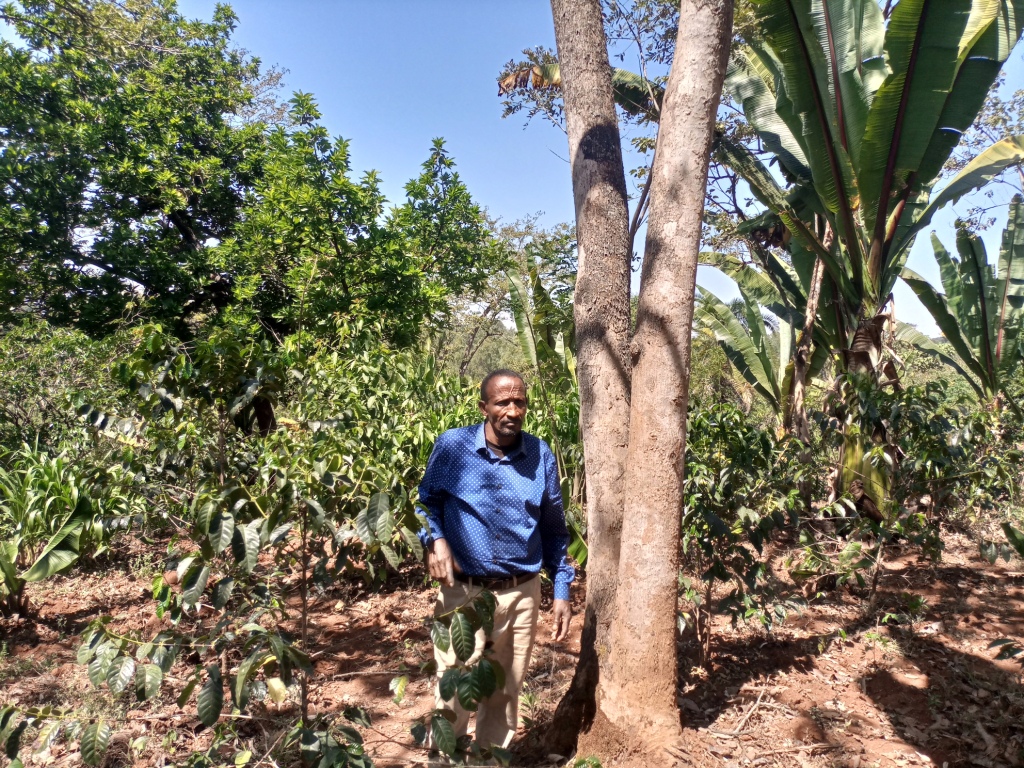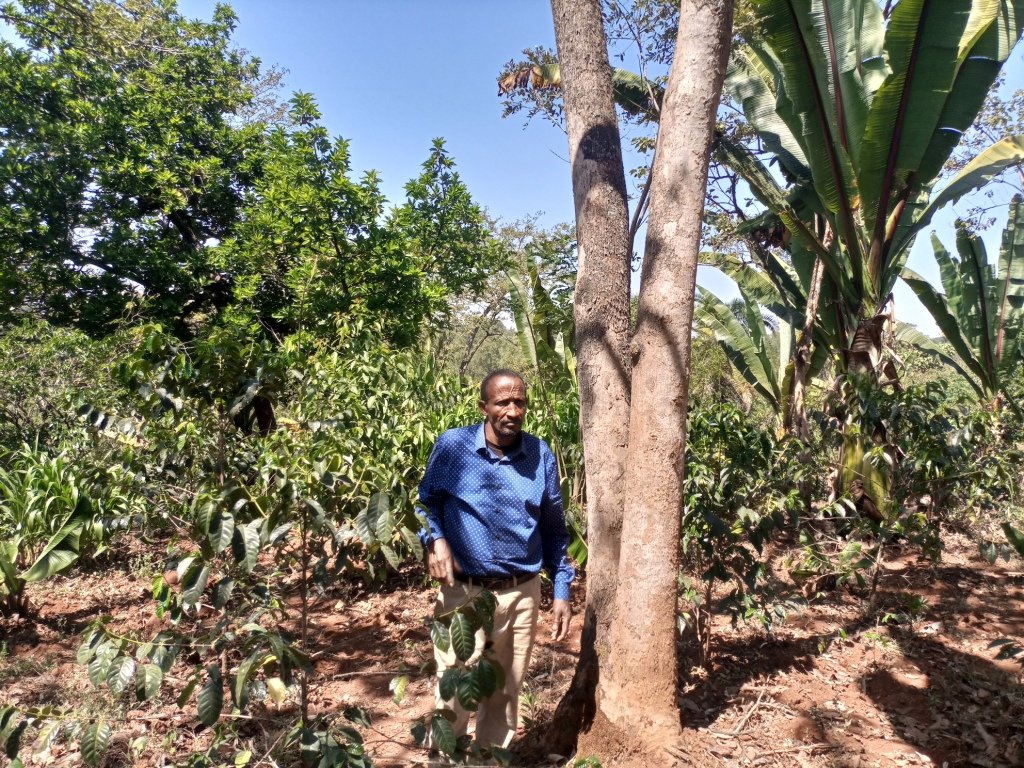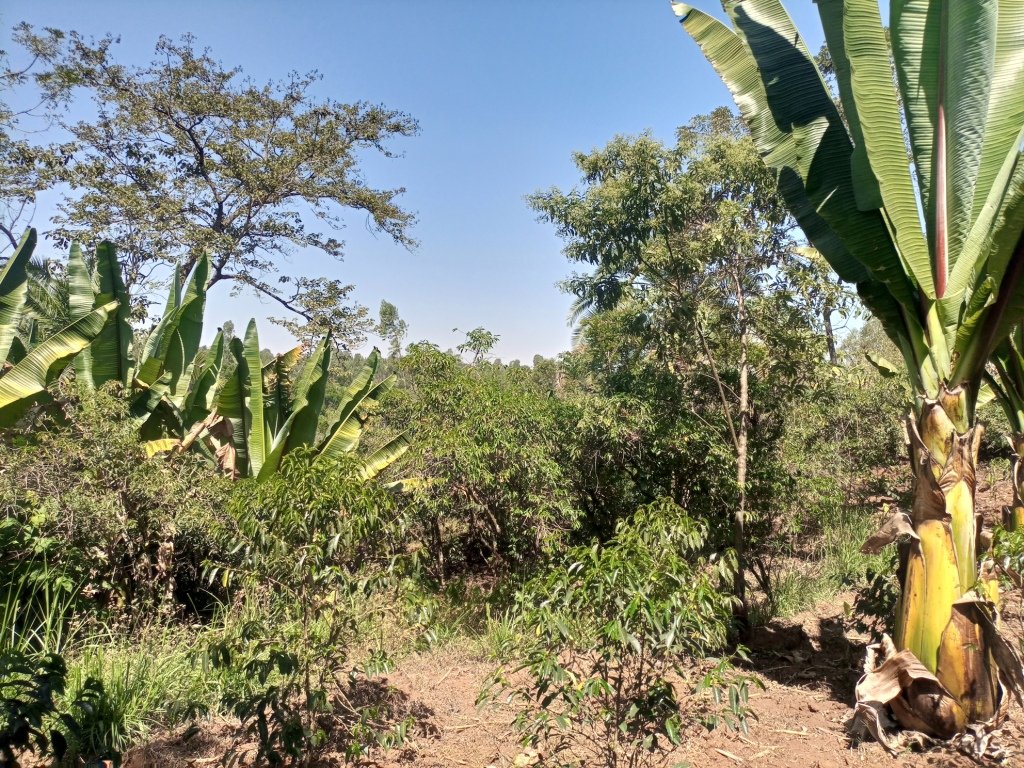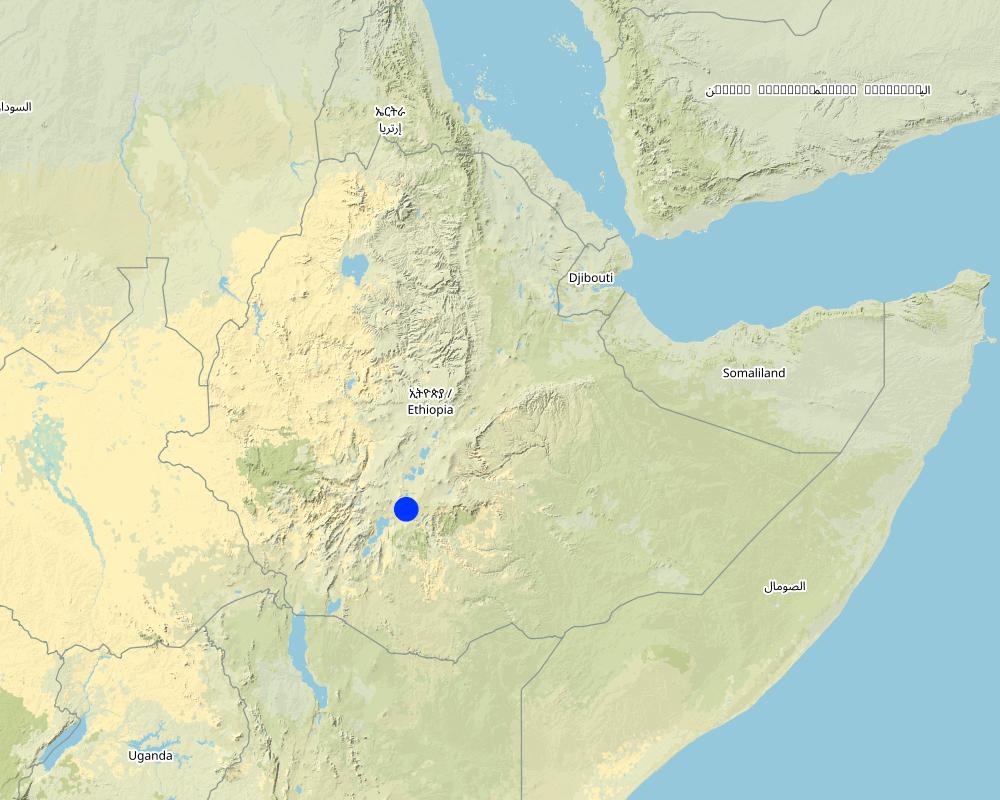Integrated Agroforestry System [ອີທິໂອເປຍ]
- ການສ້າງ:
- ປັບປູງ:
- ຜູ້ສັງລວມຂໍ້ມູນ: GERBA LETA
- ບັນນາທິການ: Julia Doldt, Noel Templer, Kidist Yilma
- ຜູ້ທົບທວນຄືນ: William Critchley, Rima Mekdaschi Studer
Mitikarsamino Ersha
approaches_6622 - ອີທິໂອເປຍ
ເບິ່ງພາກສ່ວນ
ຂະຫຍາຍທັງໝົດ ຍຸບທັງໝົດ1. ຂໍ້ມູນທົ່ວໄປ
1.2 ລາຍລະອຽດ ການຕິດຕໍ່ ຂອງບຸກຄົນທີ່ຊັບພະຍາກອນ ແລະ ສະຖາບັນ ການມີສ່ວນຮ່ວມ ໃນການປະເມີນຜົນ ແລະ ເອກະສານ ຂອງວິທີທາງ
ບຸກຄົນສຳຄັນ (ຫຼາຍຄົນ)
ຜູ້ນໍາໃຊ້ທີ່ດິນ:
Gabiba Afra
+251 934 73 5738
Farmer
Dale District, Shoye kebele Sidma Regional State Ethiopia
ອີທິໂອເປຍ
ຊື່ຂອງໂຄງການ ທີ່ອໍານວຍຄວາມສະດວກ ໃນການສ້າງເອກກະສານ ຫຼື ປະເມີນດ້ານແນວທາງ (ຖ້າກ່ຽວຂ້ອງ)
Soil protection and rehabilitation for food security (ProSo(i)l)ຊື່ຂອງ ສະຖາບັນການຈັດຕັ້ງ ທີ່ອໍານວຍຄວາມສະດວກ ໃນການສ້າງເອກກະສານ ຫຼື ປະເມີນແນວທາງ (ຖ້າກ່ຽວຂ້ອງ)
Alliance Bioversity and International Center for Tropical Agriculture (Alliance Bioversity-CIAT) - ເຄັນຢາ1.3 ເງື່ອນໄຂ ຂອງການນໍາໃຊ້ເອກກະສານຂໍ້ມູນ ຂອງ WOCAT
ເມື່ອໃດທີ່ໄດ້ສັງລວມຂໍ້ມູນ (ຢູ່ພາກສະໜາມ)?
13/01/2023
ຜູ້ສັງລວມ ແລະ ບັນດາຜູ້ຕອບແບບສອບຖາມ ຍອມຮັບໃນເງື່ອນໄຂ ການນໍາໃຊ້ຂໍ້ມູນເອກະສານ ທີ່ສ້າງຂື້ນ ໂດຍຜ່ານ ອົງການ WOCAT:
ແມ່ນ
1.4 ເອກະສານອ້າງອີງ (ຫຼາຍ) ກັບແບບສອບຖາມ (ຫຼາຍ) ເຕັກໂນໂລຢີ ຂອງດ້ານການຄຸ້ມຄອງ ດິນແບບຍືນຍົງ
2. ພັນລະນາ ແນວທາງການຄຸ້ມຄອງນໍາໃຊ້ດິນແບບຍືນຍົງ
2.1 ການອະທິບາຍ ໂດຍຫຍໍ້ ຂອງວິທີທາງ
The integrated agroforestry system is a self-initiated approach by a land user to implement agroforestry as part of an indigenous practice and has evolved over the years through technical support, training, and supplies of coffee and tree seedlings by the Office of Agriculture and Coffee Improvement Project. Had there been a participatory process throughout it would have helped in design and also in scaling up.
2.2 ການອະທິບາຍ ລາຍລະອຽດ ຂອງວິທີທາງ
ການອະທິບາຍ ລາຍລະອຽດ ຂອງວິທີທາງ:
The integrated agroforestry system was independently initiated by land users during the Derg regime (1974-91). During the regime, farmers were failed by two distinct and polar development approaches: socialist and the mainstream local approaches. The earlier one involved the communist approach of communal production and sharing the output according to contribution. The latter ones employed a conventional approach and included non-members of the so-called Farmers Producer Cooperatives. As a non-member of the earlier one, the land user had to develop his farm alone. The solitary agroforestry initiative described here has gradually evolved to a fully-fledged system that currently serves as a model SLM practice for scaling up across similar agroecological and farming system. Thus, there was little participation involved during the early intensification of agroforestry in Ethiopia. Rather, it is considered an indigenous practice that now receives publicity as a form of “regenerative agriculture” with ecological, economic, and social benefits. As it has global significance in terms of emission reduction and sequestration of carbon, it is the favourite technology among the government and other development practitioners.
The farmer started agroforestry by planting enset and coffee. Over time, with emerging technical support, access to training, and supply of coffee seedlings by the agriculture and coffee improvement project offices, the land user has continued intensification of the agroforestry around the homestead by adopting the correct planting space for coffee and enset, and other companion fruit, fodder crops, and shade trees. The former Ministry of Coffee and Tea, and the current Ministry of Agriculture have had an immense contribution by supplying technical support, training, and inputs (notably coffee and tree seedlings), and by ensuring access to fertilizers. The latter was supplied to the farmers on a credit basis through the then Service Cooperative.
As the initiative was the farmer's own, the tendency to plant incompatible crops was not uncommon. Even so, the agroforestry trees and shrubs still had immense ecological and economic value. They ameliorate the extreme temperature experienced during the dry season, improve the microclimate, recharge the surface and groundwater via improving water infiltration, and reduce runoff losses. Improving soil fertility and soil health are among other benefits. Despite the substantial benefit the technology confers on land users, the lack of a participatory approach in planning, implementation, monitoring, and evaluation at the community level restricts the adoption and scaling up of this beneficial approach. Despite the achievements of the land user, earlier engagement of other smallholders and institutionalizing the approach decades ago might have positively influenced the design as well as wider-scale adoption and application of the technology. However, regardless of any limitations, the technology is evidence-based and inspirational.
2.3 ຮູບພາບຂອງແນວທາງ
ຂໍ້ສັງເກດໂດຍທົ່ວໄປກ່ຽວກັບການຮູບພາບ:
The photo shows the practice rather than the approach. However, the existing scene is just the outcome of the approach (farmer's own) employed to establish and maintain the agroforestry practice.
2.4 ວີດີໂອ ຂອງວິທີທາງ
ຄວາມຄິດເຫັນ, ຄໍາອະທິບາຍຫຍໍ້:
Videos of the approach is not documented.
2.5 ປະເທດ / ເຂດ / ສະຖານທີ່ບ່ອນທີ່ແນວທາງໄດ້ຖືກນໍາໃຊ້
ປະເທດ:
ອີທິໂອເປຍ
ພາກພື້ນ / ລັດ / ແຂວງ:
Sidama
ຂໍ້ມູນເພີ່ມເຕີມຂອງສະຖານທີ່:
Shoye kebele (Kebele - lower administrative level).
ຄວາມຄິດເຫັນ:
As perennial crop enset (false banana) is a staple food in the area, the farming system is tree based but vary with degrees of intensification.
Map
×2.6 ວັນທີເລີ່ມຕົ້ນ ແລະ ສິ້ນສຸດ ການຈັດຕັ້ງປະຕີບັດ ວິທີທາງ
ສະແດງປີຂອງການເລີ່ມຕົ້ນ:
1980
ຄວາມຄິດເຫັນ:
It is a continuous, non-ending self initiative inheritable by the generation to come.
2.7 ປະເພດຂອງແນວທາງ
- ພື້ນເມືອງ / ທ້ອງຖີ່ນ
2.8 ເປົ້າໝາຍ / ຈຸດປະສົງຫຼັກ ຂອງການຈັດຕັ້ງປະຕິບັດ ວິທີທາງ
A traditional approach was initiated to change the land use/ land cover and optimize the benefit of the degraded land by reducing the negative effects of overgrazing and its consequence.
2.9 ເງື່ອນໄຂອໍານວຍ ຫຼື ຂັດຂວາງການປະຕິບັດຂອງເຕັກໂນໂລຢີ / ເຕັກໂນໂລຢີການນໍາໃຊ້ຕາມແນວທາງ
ສັງຄົມ / ວັດທະນະທໍາ / ມາດຕະຖານ ແລະ ຄຸນຄ່າທາງສາສະໜາ
- ອໍານວຍ
The long-standing tradition of the society promotes planting and preserving trees.
ມີຄວາມສາມາດ / ເຂັ້າເຖິງຊັບພະຍາກອນດ້ານການເງິນ ແລະ ການບໍລິການ
- ອໍານວຍ
Access to in-kind credit services such as fertilizers from farmers' cooperatives enables the land users to effectively implement the practice.
ການກໍ່ຕັ້ງສະຖາບັນ
- ເຊື່ອງຊ້ອນ
The lack of institutional setting might have influenced the rate of scaling the technology.
ການຮ່ວມມື / ການປະສານງານຂອງຜູ້ກ່ຽວຂ້ອງ
- ອໍານວຍ
Foster farmers access to training, technical support, exchange visit...
ກ່ຽວກັບກົດໝາຍ (ສິດນໍາໃຊ້ດິນ, ສິດນໍາໃຊ້ນໍ້າ)
- ອໍານວຍ
Enables the development of a sense of ownership and accountability to properly implement and manage the practice.
ຄວາມຮູ້ກ່ຽວກັບການຄຸ້ມຄອງ ທີ່ດິນແບບຍືນຍົງ, ການເຂົ້າເຖິງການສະໜັບສະໜູນ ທາງດ້ານວິຊາການ
- ອໍານວຍ
Promote effective implementation, management, and use of the return from the practice.
ຕະຫຼາດ (ໃນການຊື້ວັດຖຸດິບ, ຂາຍຜະລິດຕະພັນ) ແລະ ລາຄາ
- ອໍານວຍ
The availability of a fair and subsidized market enables the approach.
- ເຊື່ອງຊ້ອນ
Lack of reliable market compels to change the approach to another income-generating practice/approach.
ວຽກ, ມີກໍາລັງຄົນ
- ອໍານວຍ
The availability of manpower enables one to accomplish the job without pressure.
- ເຊື່ອງຊ້ອນ
Shortage of manpower disables effective implementation of the practice.
3. ການມີສ່ວນຮ່ວມ ແລະ ບົດບາດຂອງພາກສ່ວນທີ່ກ່ຽວຂ້ອງທີ່ໄດ້ມີສ່ວນຮ່ວມ
3.1 ຜູ້ມີສ່ວນຮ່ວມ ໃນວິທີທາງ ແລະ ພາລະບົດບາດ ຂອງເຂົາເຈົ້າ
- ຜູ້ນໍາໃຊ້ດິນໃນທ້ອງຖິ່ນ / ຊຸມຊົນທ້ອງຖິ່ນ
Land users and local communities
Plan and implement the technology, and sharing labor, skills and knowledge.
- ຜູ້ຊ່ຽວຊານ ການນຄຸ້ມຄອງ ທີ່ດິນແບບຍືນຍົງ / ທີ່ປຶກສາດ້ານກະສິກໍາ
Development agents (DAs) and district experts
Provide training, and technical support, facilitate land users' access to inputs such as seedlings and fertilizers, monitor and evaluate, and documentation of successful practices for pervasive application and use.
- ນັກຄົ້ນຄວ້າ
Regional Agricultural Research Institute, and under/graduate students.
Generate supportive specific and relevant technologies, learn the lesson, and recommend best-fit technologies/practices.
- ອໍານາດ ການປົກຄອງທ້ອງຖິ່ນ
District administration and colleagues
Acknowledge the farmers/technology adopters as a model to showcase their experience and encourage the scaling out of the initiative.
3.2 ການມີສ່ວນຮ່ວມຂອງຜູ້ນໍາໃຊ້ທີ່ດິນໃນທ້ອງຖິ່ນ / ຊຸມຊົນທ້ອງຖິ່ນໃນໄລຍະທີ່ແຕກຕ່າງກັນຂອງແນວທາງ
| ການລວບລວມ ເອົາຜູ້ນໍາໃຊ້ດິນ ໃນທ້ອງຖິ່ນ / ຊຸມຊົນທ້ອງຖິ່ນ | ໃຫ້ລະບຸ ຜູ້ໃດທີ່ມີສ່ວນຮ່ວມ ໃນແຕ່ລະກິດຈະກໍາ? | |
|---|---|---|
| ການເລີ່ມຕົ້ນ / ແຮງຈູງໃຈ | ການນໍາໃໍຊ້ເອງ | Land user: Initiated coffee and enset plantation little by little and accessed training and technical support from DAs and Woreda office of Agriculture experts. |
| ການວາງແຜນ | ການນໍາໃໍຊ້ເອງ | Land user and development agent: In consultation with DAs, the land users plan based on available labor and capital every other year. |
| ການປະຕິບັດ | ການນໍາໃໍຊ້ເອງ | Land users and family member. They involved in various implementation/management activities. |
| ຕິດຕາມກວດກາ / ການປະເມີນຜົນ | ການບໍ່ປະຕິບັດ | Government development agents, and experts coordinate mobilization of the communities to visit and learn from the ongoing practice. |
3.3 ແຜນວາດ (ຖ້າມີ)
ການອະທິບາຍ:
A flow chart depicting the evolution of practice from self-initiative indigenous coffee planting practices to a multistorey agroforestry system with the participation and support of public organization agents and farmers' primary cooperative.
ຜູ້ຂຽນ:
Gerba Leta
3.4 ການຕັດສິນໃຈກ່ຽວກັບການຄັດເລືອກເຕັກໂນໂລຢີຂອງການຄຸ້ມຄອງທີ່ດິນແບບຍືນຍົງ / ເຕັກໂນໂລຢີ
ລະບຸ ຄົນທີ່ຕັດສິນໃຈ ກ່ຽວກັບການຄັດເລືອກຂອງ ເຕັກໂນໂລຢີ / ເຕັກໂນໂລຢີ ຈະໄດ້ຮັບການປະຕິບັດ:
- ຜູ້ນໍາໃຊ້ດິນຜູ້ດຽວ (ການລິເລີ່ມດ້ວຍຕົນເອງ)
ອະທິບາຍ:
The land user was the initial decision maker that later cross-fertilized or complemented by research and development actors.
Specify on what basis decisions were made:
- ປະສົບການສ່ວນບຸກຄົນ ແລະ ຄວາມຄິດເຫັນ (ທີ່ບໍ່ເປັນເອກກະສານ)
4. ການສະໜັບສະໜູນທາງດ້ານວິຊາການ, ການສ້າງຄວາມສາມາດ, ແລະ ການຈັດການຄວາມຮູ້.
4.1 ການສ້າງຄວາມສາມາດ / ການຝຶກອົບຮົມ
ຜູ້ນໍາໃຊ້ທີ່ດິນ ຫຼື ພາກສ່ວນກ່ຽວຂ້ອງອື່ນໆ ໄດ້ຮັບການຝຶກອົບຮົມບໍ່?
ແມ່ນ
ໃຫ້ລະບຸ ຜູ້ໃດທີ່ໄດ້ຮັບການຝຶກອົບຮົມ:
- ຜູ້ນໍາໃຊ້ດິນ
- Development agents
ຖ້າເປັນໄປໄດ້, ໃຫ້ລະບຸເພດ, ອາຍຸ, ສະຖານະພາບ, ຊົນເຜົ່າ, ແລະ ອື່ນໆ:
Training is usually provided to literate farmers who are capable of reading, taking notes, and sharing with other peers back home. Women-headed household are inclusive to represent the gender parity.
ຮູບແບບຂອງການຝຶກອົບຮົມ:
- ກອງປະຊຸມ
ຮູບແບບຂອງການຝຶກອົບຮົມ:
- Training and visit
ໃນຫົວຂໍ້:
Coffee production and management such as preparation of planting pits, refilling the soil back to the pit, planting space, fertilizer application, weeding, mulching, planting shade trees, etc.
ຄວາມຄິດເຫັນ:
Integrating enset, shade trees, and soil bunds with productive barriers into the farm eventually evolves into the agroforestry system.
4.2 ການບໍລິການໃຫ້ຄໍາປຶກສາ
ເຮັດຜູ້ໃຊ້ທີ່ດິນມີການເຂົ້າເຖິງການບໍລິການໃຫ້ຄໍາປຶກສາ?
ແມ່ນ
ລະບຸວ່າການສະໜອງ ການບໍລິການ ໃຫ້ຄໍາປຶກສາ:
- ໃນພື້ນທີ່ຂອງຜູ້ນໍາໃຊ້ດິນ
- ສູນຄົ້ນຄວ້າ
ອະທິບາຍ / ຄວາມຄິດເຫັນ:
The training used to be given in permanent centers such as development stations in the past and Farmers Training Center since recent a decade ago and was associated with a visit to a farmers field.
4.3 ສະຖາບັນການສ້າງຄວາມເຂັ້ມແຂງ (ການພັດທະນາອົງການຈັດຕັ້ງ)
ສະຖາບັນ ໄດ້ຮັບການສ້າງຕັ້ງຂື້ນ ຫຼື ໄດ້ຮັບການສ້າງຄວາມເຂັ້ມແຂງ ໂດຍການຈັດຕັ້ງປະຕິບັດ ວິທີທາງບໍ່?
- ບໍ່ມີ
4.4 ຕິດຕາມກວດກາ ແລະ ປະເມີນຜົນ
ການຈັດຕັ້ງປະຕິບັດ ວິທີທາງ ໄດ້ມີການປະເມີນຜົນ ແລະ ຕິດຕາມບໍ?
ບໍ່ແມ່ນ
ຄວາມຄິດເຫັນ:
A sort of visit may be organized by development agents to the coffee plantation but not in a way address the role of monitoring and evaluation and documentation.
4.5 ການຄົ້ນຄວ້າ
ນີ້້ແມ່ນສ່ວນໜຶ່ງ ການຄົ້ນຄວ້າ ຂອງວິທີທາງບໍ່?
ບໍ່ແມ່ນ
5. ການສະໜັບສະໜູນທາງດ້ານການເງິນ ແລະ ອຸປະກອນຈາກພາຍນອກ
5.1 ງົບປະມານປະຈໍາປີ ສໍາລັບວິທີທາງ ຂອງການຄຸ້ມຄອງ ທີ່ດິນແບບຍືນຍົງ
ຖ້າຫາກບໍ່ຮູ້ຈັດງົບປະມານທີ່ແນ່ນອນ ແມ່ນໃຫ້ປະມານເອົາ:
- < 2,000
ຄໍາເຫັນ (ຕົວຢ່າງ: ແຫຼ່ງຂໍ້ມູນຫຼັກ ຂອງການສະໜອງທຶນ / ຜູ້ໃຫ້ທຶນທີ່ສໍາຄັນ):
Only in kind support such as coffee seedlings and technical support such as advisory service was provide by the government agricultural office through development/extension agents. Otherwise, it is privately financed business with main expense geared toward supplying seedlings and agricultural inputs such as fertilizers.
5.2 ການສະໜັບສະໜູນ ທາງດ້ານການເງິນ / ອຸປະກອນ ສະໜອງໃຫ້ແກ່ຜູ້ນໍາທີ່ດິນ
ຜູ້ນໍາໃຊ້ດິນ ໄດ້ຮັບການສະໜັບສະໜູນ ທາງດ້ານ ການເງິນ / ອຸປະກອນ ໃນການຈັດຕັ້ງປະຕິບັດ ເຕັກໂນໂລຢີບໍ?
ແມ່ນ
ຖ້າແມ່ນ, ໃຫ້ລະບຸປະເພດ (ຫຼາຍ) ຂອງການສະໜັບສະໜູນ, ເງື່ອນໄຂ ແລະ ຜູູ້ສະໜອງ (ຫຼາຍ):
In the past (during Derg regime) there was subsidy for fertilizers as a country which is entirely removed in the recent years.
5.3 ເງິນສົມທົບສໍາລັບການນໍາໃຊ້ສະເພາະປັດໃຈຂາເຂົ້າໃນການຜະລີດກະສິກໍາ (ລວມທັງແຮງງານ)
- ອື່ນໆ
| ອື່ນໆ (ລະບຸ) | ທີ່ຂອບເຂດ | ລະບຸ ການອຸດໜູນ |
|---|---|---|
| Fertilizer | ງົບປະມານບາງສ່ວນ | In the past, the government import and supply fertilizer on subsidized basis. The trend was changed over the last a couple of decades. |
ຖ້າແຮງງານ ຂອງຜູ້ນໍາໃຊ້ດິນ ໄດ້ຮັບການສະໜັບສະໜູນ ປັດໃຈຂາເຂົ້າ, ແມ່ນບໍ່:
- ການອາສາ
ຄວາມຄິດເຫັນ:
Family labor used to manage the family farm.
5.4 ສິນເຊື່ອ
ໄດ້ປ່ອຍສິນເຊື່ອ ສະໜອງໃຫ້ພາຍໃຕ້ ວິທີການສໍາລັບກິດຈະກໍາ ການຄຸ້ມຄອງ ທີ່ດິນແບບຍືນນຍົງບໍ່?
ບໍ່ແມ່ນ
5.5 ສິ່ງຈູງໃຈ ຫຼື ເຄື່ອງມືອື່ນໆ
ການສົ່ງເສີມ ຈັດຕັ້ງປະຕິບັດ ເຕັກໂນໂລຢີ ໃນການຄຸ້ມຄອງ ດິນແບບຍືນຍົງ ໄດ້ສະໜອງສິ່ງກະຕຸກຊຸກຍູ້ບໍ່?
ບໍ່ແມ່ນ
6. ວິເຄາະຜົນກະທົບ ແລະ ສັງລວມບັນຫາ
6.1 ຜົນກະທົບຂອງແນວທາງ
ວິທີທາງ ຊ່ວຍຊຸກຍູ້ ຜູ້ນຳໃຊ້ທີ່ດິນທ້ອງຖີ່ນ, ໃນການປັບປຸງ ການມີສ່ວນຮ່ວມ ຂອງຜູ້ທີ່ກ່ຽວຂ້ອງ ບໍ່?
- ບໍ່
- ມີ, ໜ້ອຍໜຶ່ງ
- ມີ, ພໍສົມຄວນ
- ມີ, ຫຼາຍ
The approach was mainly based on self initiative. The assistance that came in later on was top-down where farmers were urged to plant coffee and companion tree crops. However, later it has evolved into agroforestry and SLM that empower local land users to join.
ການນໍາໃຊ້ ວິທີທາງ ດັ່ງກ່າວນີ້ ສາມາດເປັນຫຼັກຖານ ທີ່ສະໜັບສະໜູນ ໃຫ້ການຕັດສິນໃຈໄດ້ບໍ່?
- ບໍ່
- ມີ, ໜ້ອຍໜຶ່ງ
- ມີ, ພໍສົມຄວນ
- ມີ, ຫຼາຍ
It is not entirely the approach but the outcome of intensifying the technology that eventually enables land users and other stakeholders to make an evidence-based decision.
ການຈັດຕັ້ງປະຕິບັດ ວິທີທາງ ສາມາດຊ່ວຍຜູ້ນໍາໃຊ້ທີ່ດິນ ໃນການຈັດຕັ້ງປະຕິບັດ ແລະ ບໍາລຸງຮັກສາ ເຕັກໂນໂລຢີ ການຄຸ້ມຄອງ ທີ່ດິນແບບຍືນຍົງໄດ້ບໍ?
- ບໍ່
- ມີ, ໜ້ອຍໜຶ່ງ
- ມີ, ພໍສົມຄວນ
- ມີ, ຫຼາຍ
The prevailing system compels farmers to integrate land management practices such as soil bunds, food and non-food tree species into the farm that enable land users to adopt and uphold SLM technology.
ການນໍາໃຊ້ ວິທີທາງ ສາມາດປັບປຸງ ການປະສານງານ ແລະ ຄ່າໃຊ້ຈ່າຍ ການຈັດຕັ້ງປະຕິບັດ ທີ່ມີປະສິດທິພາບ ຂອງການຄຸ້ມຄອງ ທີ່ດິນແບບຍືດຍົງໄດ້ບໍ່?
- ບໍ່
- ມີ, ໜ້ອຍໜຶ່ງ
- ມີ, ພໍສົມຄວນ
- ມີ, ຫຼາຍ
ການນໍາໃຊ້ ວິທີທາງ ສາມາດລະດົມ ຫຼື ປັບປຸງ ການເຂົ້າເຖິງຊັບພະຍາກອນ ການເງິນ ສໍາລັບການຈັດຕັ້ງປະຕິບັດ ການຄຸ້ມຄອງ ທີ່ດິນແບບຍືດຍົງໄດ້ບໍ່?
- ບໍ່
- ມີ, ໜ້ອຍໜຶ່ງ
- ມີ, ພໍສົມຄວນ
- ມີ, ຫຼາຍ
,
ການນໍາໃຊ້ ວິທີທາງ ສາມາດປັບປຸງຄວາມຮູ້ ແລະ ຄວາມສາມາດຂອງຜູ້ນໍາໃຊ້ທີ່ດິນ ໃນການປະຕິບັດ ການຄຸ້ມຄອງ ທີ່ດິນແບບຍືດຍົງໄດ້ບໍ່?
- ບໍ່
- ມີ, ໜ້ອຍໜຶ່ງ
- ມີ, ພໍສົມຄວນ
- ມີ, ຫຼາຍ
Through public meetings and social learning from peers and better-off farmers, land users' knowledge and skills to implement the technology have been improved.
ການນໍາໃຊ້ ວິທີທາງ ສາມາດປັບປຸງຄວາມຮູ້ ແລະ ຄວາມສາມາດ ຂອງພາກສ່ວນທີ່ກ່ຽວຂ້ອງໄດ້ບໍ່?
- ບໍ່
- ມີ, ໜ້ອຍໜຶ່ງ
- ມີ, ພໍສົມຄວນ
- ມີ, ຫຼາຍ
Virtually through social learning and labor sharing.
ການນໍາໃຊ້ ວິທີທາງ ສາມາດສ້າງຄວາມເຂັ້ມແຂງ ໃຫ້ສະຖາບັນການຈັດຕັ້ງ, ການຮ່ວມມື ລະຫວ່າງພາກສ່ວນທີ່ກ່ຽວຂ້ອງບໍ່?
- ບໍ່
- ມີ, ໜ້ອຍໜຶ່ງ
- ມີ, ພໍສົມຄວນ
- ມີ, ຫຼາຍ
It was a solitary approach but later adopted by numerous land users.
ການນໍາໃຊ້ ວິທີທາງ ສາມາດຫຼຸດຜ່ອນ ຂໍ້ຂັດແຍ່ງໄດ້ບໍ່?
- ບໍ່
- ມີ, ໜ້ອຍໜຶ່ງ
- ມີ, ພໍສົມຄວນ
- ມີ, ຫຼາຍ
ການຈັດຕັ້ງປະຕິບັດ ວິທີທາງ ສາມາດສ້າງຄວາມເຂັ້ມແຂງ ທາງສັງຄົມ ແລະ ເສດຖະກິດບໍ່?
- ບໍ່
- ມີ, ໜ້ອຍໜຶ່ງ
- ມີ, ພໍສົມຄວນ
- ມີ, ຫຼາຍ
It doesn't deliberate about gender disparity and equity as it was an indigenous initiative in the long past.
ການຈັດຕັ້ງປະຕິບັດ ວິທີທາງ ສາມາດປັບປຸງ ຄວາມສະເໜີພາບ ຂອງບົດບາດ ຍິງຊາຍ ແລະ ສ້າງຄວາມເຂັ້ມແຂງໃຫ້ຜູ້ຍິງໄດ້ບໍ່?
- ບໍ່
- ມີ, ໜ້ອຍໜຶ່ງ
- ມີ, ພໍສົມຄວນ
- ມີ, ຫຼາຍ
ການຈັດຕັ້ງປະຕິບັດ ວິທີທາງ ສາມາດຊຸກຍູ້ ຜູ້ນໍາໃຊ້ທີ່ດິນທີ່ເປັນຊາວໜຸ່ມ / ຄົນລຸ້ນໃໝ່ ໃນການຄຸ້ມຄອງ ທີ່ດິນແບບຍືນຍົງໄດ້ບໍ?
- ບໍ່
- ມີ, ໜ້ອຍໜຶ່ງ
- ມີ, ພໍສົມຄວນ
- ມີ, ຫຼາຍ
The established technology built youths trust in SLM.
ການຈັດຕັ້ງປະຕິບັດ ວິທີທາງ ສາມາດປັບປຸງ ປະເດັນການຖືຄອງທີ່ດິນ / ສິດທິໃນການນໍາໃຊ້ທີ່ດິນ ທີ່ເຊື່ອງຊ້ອນໃນການຈັດຕັ້ງປະຕິບັດ ເຕັກໂນໂລຢີ ການຄຸ້ມຄອງ ທີ່ດິນແບບຍືນຍົງໄດ້ບໍ?
- ບໍ່
- ມີ, ໜ້ອຍໜຶ່ງ
- ມີ, ພໍສົມຄວນ
- ມີ, ຫຼາຍ
ການນໍາໃຊ້ ວິທີທາງ ໄດ້ປັບປຸງ ການຄໍ້າປະກັນສະບຽງອາຫານ ຫຼື ປັບປຸງໂຄສະນາການໄດ້ບໍ່?
- ບໍ່
- ມີ, ໜ້ອຍໜຶ່ງ
- ມີ, ພໍສົມຄວນ
- ມີ, ຫຼາຍ
Actually, implementing the agroforestry improved food and nutrition security of the family farmers.
ການຈັດຕັ້ງປະຕິບັດ ວິທີທາງ ສາມາດປັບປຸງ ການເຂົ້າເຖິງຕະຫຼາດໄດ້ບໍ?
- ບໍ່
- ມີ, ໜ້ອຍໜຶ່ງ
- ມີ, ພໍສົມຄວນ
- ມີ, ຫຼາຍ
Harvest from the integrated system improved farmer's access to market.
ການນໍາໃຊ້ ວິທີທາງ ໄດ້ປັບປຸງ ການເຂົ້າເຖິງນໍ້າ ແລະ ສາຂາພິບານໄດ້ບໍ່?
- ບໍ່
- ມີ, ໜ້ອຍໜຶ່ງ
- ມີ, ພໍສົມຄວນ
- ມີ, ຫຼາຍ
ການນໍາໃຊ້ ວິທີທາງ ໄດ້ປັບປຸງ ການນໍາໃຊ້ແຫຼ່ງພະລັງງານ ແບບຍືນຍົງຫຼາຍຂື້ນບໍ່?
- ບໍ່
- ມີ, ໜ້ອຍໜຶ່ງ
- ມີ, ພໍສົມຄວນ
- ມີ, ຫຼາຍ
Through promoting biogas technology in mixed tree-crop-livestock system.
ການຈັດຕັ້ງປະຕິບັດ ວິທີທາງ ສາມາດສ້າງຄວາມອາດສາມາດໃຫ້ຜູ້ນໍາໃຊ້ດິນ ໃນການປັບຕົວ ຕໍ່ການປ່ຽນແປງດິນຟ້າອາກາດ / ຫຼດຜ່ອນຄວາມສ່ຽງທາງໄພພິບັດໄດ້ບໍ? :
- ບໍ່
- ມີ, ໜ້ອຍໜຶ່ງ
- ມີ, ພໍສົມຄວນ
- ມີ, ຫຼາຍ
Again, it is not the approach but the applied technology has improved farmers adaptation to climate change/climate variability.
ການນໍາໃຊ້ ວິທີທາງ ໄດ້ປັບປຸງ ການຈ້າງງານ, ໂອກາດ ໃນການສ້າງລາຍຮັບບໍ່?
- ບໍ່
- ມີ, ໜ້ອຍໜຶ່ງ
- ມີ, ພໍສົມຄວນ
- ມີ, ຫຼາຍ
It creates all year round employment opportunity for family labor and other casual laborers.
6.2 ແຮງຈູງໃຈຫຼັກຂອງຜູ້ນໍາໃຊ້ທີ່ດິນໃນການປະຕິບັດການຄຸ້ມຄອງທີ່ດິນແບບຍືນຍົງ
- ການຜະລິດເພີ່ມຂຶ້ນ
Improve crop production and productivity; diversify crops and reduces risks of crop failure; improved soil fertility and reduce runoff.
- ກໍາໄລເພີ່ມຂຶ້ນ (ຄວາມສາມາດ), ການປັບປຸງຄ່າໃຊ້ຈ່າຍ, ຜົນປະໂຫຍດ, ອັດຕາສ່ວນ
Land users managed to generate income from the sale of cash crops such as coffee, and fruits as compared to the investment in managing the system.
- ຫຼຸດຜ່ອນດິນເຊື່ອມໂຊມ
Permanent land cover by trees, shrubs, and perennial food, cash, and fodder crops reduces land degradation. Also, enrich the land with litter and organic matter.
- ຫຼຸດຜ່ອນຄວາມສ່ຽງຂອງໄພພິບັດ
Reduce the risk of flood and soil runoff, diversify crops and reduce the risk of failure owning to climate change/variability.
- ກຽດສັກສີ, ຄວາມກົດດັນທາງສັງຄົມ / ການຕິດຕໍ່ກັນທາງສັງຄົມ
Land user becoming the richest in the community implies earning from the investment makes her/his prestigious within the community.
- ຄວາມຮັບຮູ້ ທາງສີ່ງແວດລ້ອມ
The reduction of adverse effects due to the implementation of the technology allows for an increase in environmental consciousness.
- ການປັບປຸງ ຄວາມຮູ້ ແລະ ຄວາມສາມາດ ຂອງການຄຸ້ມຄອງ ທີ່ດິນແບບຍືນຍົງ
6.3 ຄວາມຍືນຍົງຂອງກິດຈະກໍາວິທີທາງ
ຜູ້ນໍາໃຊ້ ທີ່ດິນ ສາມາດສືບຕໍ່ ການຈັດຕັ້ງປະຕິບັດ ຜ່ານວິທີທາງໄດ້ບໍ່ (ໂດຍປາດສະຈາກ ການຊ່ວຍເຫຼືອ ຈາກພາກສ່ວນພາຍນອກ)?
- ແມ່ນ
ຖ້າ ໄດ້, ອະທິບາຍເຫດຜົນ:
Despite the implementation approach employed by the land user, the technology is highly commended by the land users and the public at large. The income generated from the sale of crops adequately supports the livelihoods of family farmers as well as effectively finances the maintenance of the system. However, the new beginners need external support to make sure the technology is properly implemented and scaled out for wider application and use.
6.4 ຈຸດແຂງ / ຂໍ້ດີ ຂອງວິທີທາງ
| ຈຸດແຂງ / ຂໍ້ດີ / ໂອກາດໃນການນໍາໃຊ້ທີ່ດິນ |
|---|
| Enables improved crop production and productivity and reduces risks of crop failure due to climate change/variability. |
| Motivate farmers to reduce soil erosion and land degradation and improve soil fertility. |
| The approach creates an enabling environment to intensify agroforestry and improve the microclimate of the area and ensure sustainability of the system. |
| Increased land users' status in the community to feel confident as local elites and friendliness to the environment. |
| ຈຸດແຂງ / ຈຸດດີ / ໂອກາດ ຈາກທັດສະນະຂອງຜູ້ປ້ອນຂໍ້ມູນ ຫຼື ບຸກຄົນສຳຄັນ |
|---|
| The agroforestry system creates economic, ecological, and social benefits for the family farm. |
| It ensures sustainable land management becomes in place as well as improves land users' understanding of SLM. |
| Ensure productivity and product stability, and serve as a permanent source of income and insurance for a family farmer. |
6.5 ຈຸດອ່ອນ / ຂໍ້ເສຍຂອງແນວທາງ ແລະ ວິທີການແກ້ໄຂໃຫ້ເຂົາເຈົ້າ
| ຈຸດອ່ອນ / ຂໍ້ເສຍ / ຄວາມສ່ຽງໃນມູມມອງຂອງຜູ້ນໍາໃຊ້ທີ່ດິນ | ມີວິທີການແກ້ໄຂຄືແນວໃດ? |
|---|---|
| Failure to promote collective action that end up with shortage of labor with increasing size/ areas of technology. | Establish and promote collective action and labor-sharing techniques. |
| Lack of participatory planning and decision make to put in place proper trees-crops integration. | Promote participation that enables to select and plant trees and crops with desirable characteristics to the agroforestry system. |
| Lack of active women participation with clear role and their share of the benefit from the system. | Improve women's participation and share of the benefit. |
| ຈຸດອ່ອນ ຫຼື ຂໍ້ເສຍ ຫຼື ຄວາມສ່ຽງ ໃນມຸມມອງຂອງ ຜູ້ສັງລວມຂໍ້ມູນ ຫຼື ບັນດາຜູ້ຕອບແບບສອບຖາມ | ມີວິທີການແກ້ໄຂຄືແນວໃດ? |
|---|---|
| Lower level of mainstreaming the approach and the technology at earlier stage that led to land users lower level of understanding of the multi-storey agroforestry system. | Improve land users understanding of Agroforestry and the SLM through capacity building and exchange visits. |
| The solitary approach led to relatively lower adoption of the technology. | Improve participation, access to training, technical support, and credit services to optimize the benefit of land users at scale. |
| Evolving the approach from solitary approach to large mass of land users constrained by shortage of farmland. | Promote intensification through introduction of high - value crops and optimize the return from the smaller holdings. |
7. ເອກກະສານອ້າງອີງ ແລະ ຂໍ້ມູນການເຊື່ອມໂຍງ
7.1 ວິທີການ / ແຫຼ່ງຂໍ້ມູນ
- ການໄປຢ້ຽມຢາມພາກສະໜາມ, ການສໍາຫຼວດພາກສະໜາມ
3
- ການສໍາພາດ ຜູ້ນໍາໃຊ້ທີ່ດິນ
One land user
- ສໍາພາດ ຊ່ຽວຊານ ການຄຸ້ມຄອງ ດິນແບບຍືນຍົງ
2
7.2 ເອກະສານທົ່ວໄປທີ່ສາມາດໃຊ້ໄດ້
ຫົວຂໍ້, ຜູ້ຂຽນ, ປີ, ISBN:
An Agroforestry Guide for Field Practitioners. 2013. ISBN 978-92-9059-333-1
ມີຢູ່ໃສ?ມູນຄ່າເທົ່າໃດ?
https://www.worldagroforestry.org
7.3 ການເຊື່ອມຕໍ່ກັບຂໍ້ມູນທີ່ກ່ຽວຂ້ອງທີ່ສາມາດໃຊ້ອອນໄລນ໌
ຫົວຂໍ້ / ພັນລະນາ:
SUSTAINABLE LAND USE FORUM
URL:
http://publication.eiar.gov.et
ຂໍ້ມູນການເຊື່ອມຕໍ່ ແລະ ເນື້ອໃນ
ຂະຫຍາຍທັງໝົດ ຍຸບທັງໝົດການເຊື່ອມຕໍ່
ບໍ່ມີຂໍ້ມູນການເຊື່ອມຕໍ່
ເນື້ອໃນ
ບໍ່ມີເນື້ອໃນ






